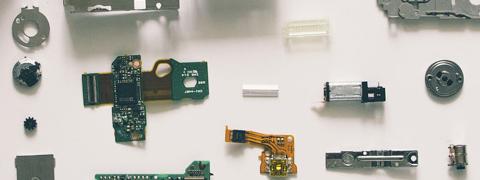[dropcap style=”font-size:100px; color:#992211;”]W[/dropcap]e’ll all be a lot happier when the boffins come up with a pair of sunglasses that stay intact when we, inevitably, sit on them.
Although perhaps not the boffins themselves. It’s the frames that they’re always having to bandage together.
Scientists at Yale University have devised a dramatically faster way of identifying and characterizing complex alloys known as bulk metallic glasses (BMGs), a versatile type of pliable glass that’s stronger than steel.
Melting temperature and malleability
Using traditional methods, it usually takes a full day to identify a single metal alloy appropriate for making BMGs. The new method allows researchers to screen about 3,000 alloys per day and simultaneously ascertain certain properties, such as melting temperature and malleability.
“Instead of fishing with a single hook, we’re throwing a big net,” said Jan Schroers, senior author of the research, which was published in the journal Nature Materials. “This should dramatically hasten the discovery of BMGs and new uses for them.”
BMGs are metal alloys composed typically of three or more elements, such as magnesium, copper, and yttrium (Mg-Cu-Y). Certain combinations of elements, when heated and cooled to specific temperatures at specific rates, result in materials with unusual plasticity and strength. They can be used for producing hard, durable, and seamless complex shapes that no other metal processing method can.
Already used in watch components, golf clubs, and other sporting goods, BMGs also have likely applications in biomedical technology, such as implants and stents, mobile phones, and other consumer electronics, said Schroers, who is professor of mechanical engineering and materials science at the Yale School of Engineering & Applied Science.
He said there are an estimated 20 million possible BMG alloys. About 120,000 metallic glasses have been produced and characterized to date.
Using standard methods, it would take about 4,000 years to process all possible combinations, Schroers has calculated. The new method could reduce the time to about four years.
Parallel blow forming with combinatorial sputtering
The technique combines a process called parallel blow forming with combinatorial sputtering. Blow forming generates bubble gum-like bubbles from the alloys and indicates their pliability. Co-sputtering is used for fabricating thousands of alloys simultaneously; alloy elements are mixed at various controlled ratios, yielding thousands of millimeter size and micron thick samples.
“Instead of blowing one bubble on one material, we blow-form 3,000 bubbles on 3,000 different materials,” Schroers said.
Since 2010, he and his research team have tested about 50,000 alloys using the new method and identified three specific new BMG alloys. They are focused on 10 alloy families.
Ideal BMGs offer plasticity during the manufacturing process, durability, and biocompatibility, along with affordability, Schroers said. Some constituent elements can be costly.
Source: Yale University
Image: Vadim Sherbakov

Some of the news that we find inspiring, diverting, wrong or so very right.




















